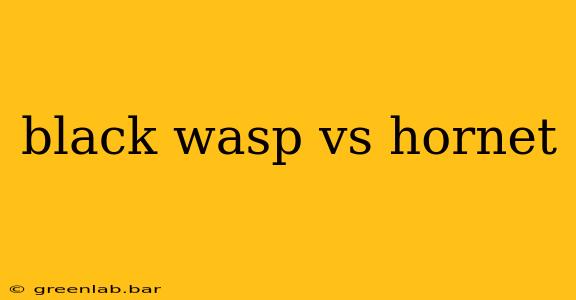The buzzing of a large, black insect can be alarming, leading many to confuse black wasps and hornets. While both possess stinging capabilities and share a similar menacing appearance, key differences exist in their behavior, appearance, and social structure. This guide will delve into the specifics, helping you confidently distinguish between these formidable insects.
Physical Distinctions: Size, Shape, and Markings
While color can be deceiving (many wasps and hornets exhibit black markings), size and body shape offer more reliable distinctions.
Size:
- Hornets: Generally larger than wasps, with queens often reaching lengths exceeding an inch.
- Black Wasps: Sizes vary considerably depending on the species, but generally smaller than hornets, rarely exceeding ¾ of an inch.
Shape:
- Hornets: Possess a robust, stocky body with a noticeably wider abdomen compared to their thorax (the middle section).
- Black Wasps: Often have a more slender build, with a less pronounced difference between the abdomen and thorax.
Markings:
While both can be predominantly black, paying close attention to details can help differentiate them.
- Hornets: Many hornet species display additional color markings, such as yellow, orange, or brown stripes or spots. The European hornet, for instance, has a characteristic reddish-brown head and thorax.
- Black Wasps: Some black wasp species might exhibit subtle yellow or white markings, but they are generally less prominent than those found on hornets.
Nest and Social Structure: A Key Differentiator
The structure of the nest and social behavior significantly distinguish black wasps from hornets.
Nest Construction:
- Hornets: Hornets are eusocial insects, meaning they live in large, complex colonies with a queen, workers, and drones. Their nests are typically large, enclosed structures made of a paper-like material, often located in tree hollows, attics, or wall voids.
- Black Wasps: Many black wasp species are solitary, with females building individual nests in the ground or in crevices. Social species exist, but their nests are generally smaller and less complex than those built by hornets.
Social Behavior:
- Hornets: Hornets exhibit aggressive defense of their nests and are more likely to sting if provoked. Their large colonies result in a higher potential for multiple stings.
- Black Wasps: Solitary black wasps are generally less aggressive, stinging only if directly threatened. Social species can display varying levels of aggression, often less pronounced than hornets.
Behavior and Habitat: Where to Find Them
Observing their behavior and habitat can provide additional clues.
- Hornets: Often found foraging for food in a wide variety of areas, including gardens, forests, and around human habitation. They are strong fliers and capable of traveling significant distances.
- Black Wasps: Habitats vary considerably depending on the species. Many species are found in grasslands, woodlands, and gardens. Their flight patterns might be less vigorous than that of hornets.
Venom and Sting: Severity of the Reaction
Both hornets and black wasps possess venomous stings. However, the severity of the reaction varies depending on individual sensitivity and the amount of venom injected.
- Hornet Stings: Generally more painful due to the larger amount of venom delivered. Multiple stings can lead to serious systemic reactions in sensitive individuals.
- Black Wasp Stings: While painful, stings from black wasps are generally less severe than hornet stings. However, allergic reactions are still possible.
Conclusion: Safe Identification and Response
Accurately identifying black wasps and hornets is crucial for determining appropriate response. While both insects are capable of stinging, understanding the differences in their appearance, behavior, and nest structure can help minimize risk. If you encounter a large, black stinging insect, maintaining a safe distance and avoiding unnecessary provocation is always the best course of action. If stung, monitor for allergic reactions and seek medical attention if necessary. Consider contacting pest control professionals for nest removal if the situation warrants it.

